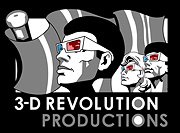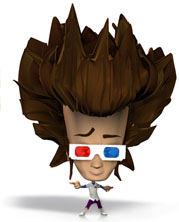3DTV production - The current state of play and where it's headed
The digital switchover just happened last year in the UK after 57 years of analogue television history. But this digital switchover did not incorporate 3-D technology and its requirements and so 3-D Television has a problem. Let me explain why.
Side-by-side 3-D TV encoding format
The EBU and its 3DTV research group, together with the DVB3D platform have just issued a recommendation to the governing bodies in the EU to accept as a standard for 3DTV the side-by-side method of encoding only. This is fine for viewers with a 3-D TV set (if they can find the 3D format switch buttin on their remote), but not for people who haven't bought a new 3DTV yet and who are waiting until their new non-3D HDTV breaks down before they buy a new model - possibly with 3-D capabilities but possibly without. The issue is that because there has been no inclusion of 3-D formats in the digital switchover specification, a side-by-side 3D TV broadcast cannot be seen in 2-D by a non-3D TV screen and as such is not backwards-compatible. This means that public broadcasters will not engage with 3DTV so as not to exclude viewers from their programming. It is a simple matter of public broadcasting rules.
So fine, 3-D TV will only be available through premium packages on Cable and Satellite and through premium VOD services. What's the problem? Lower licence fees and low co-production investments. As more and more 3D channels open shop on non-public platforms, licence fees will automatically go down and the amount of money invested in new programming with it as well. Very quickly 3D Stereoscopic television programs will not command the kind of money they need to claw back the extra costs connected with 3-D production. No producer is going to absorb 20%-30% extra costs of production, let alone 50% extra for high-quality programming, just for the sake of producing 3-D. There is little business sense in incurring a loss and so with the fall of licence fees there is no more business model for 3-D production. 2-D will be the only profitable product left to make.
3-D Film production will face the same problems when 2-D cinema ticket prices will be raised up to current 3-D film premium prices, which is definitely on the cards. Without a premium price to cover the extra costs associated with 3-D production, Stereoscopic film and television will die a quick and painful death in the coming decade.
Time for a 3-D switchover then and open up stereoscopic viewing to the full extend of the television audience? Beware that a second switchover in, say, 10 years, will most definitely also include other premium image factors currently being pushed by eager projection and television screen sales departments. Are you really future-proof - beyond just 3-D - and ready to engage with:
- 4K (4K projection is already being practised)
- 144 fps framefrates (48-144 fps shooting / rendering already being done)
- 2.39 Scope aspect ratio (2560x1080p 58’’ TV already for sale)
- 12bit TV screens (full 16-12bit pipeline already standard)
- Multi-angle delivery (MVP already part of 3-D Bluray standard)
- 4-D (External cues for Moving seats, Vibrating controllers, Smell-O-Vision)
Nintendo 3DS - a new and totally different
kind of 3-D content production is required
3-D Revolution Productions can help you with consultation and production assistance. Stereoscopic 3-D is manageable when you know how to adjust your existing pipeline to make the image as good and budget realistic in 3-D as it can possibly be - and of course safe to watch by all audience target ages. Visit our site or contact us by e-mail or telephone:
www.the3drevolution.com
info [at] the3drevolution.com
Tel. +44 1179441449










